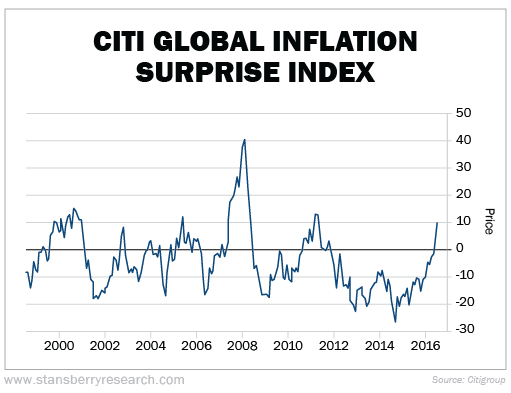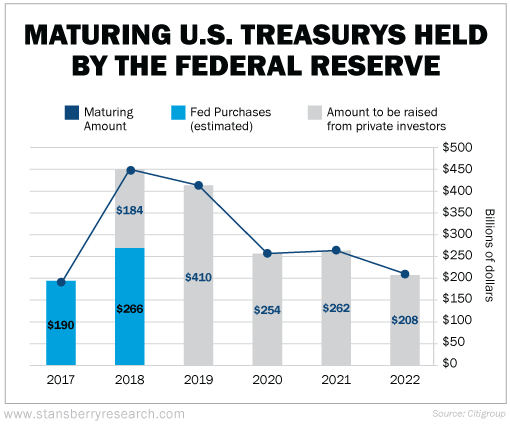| Home | About Us | Resources | Archive | Free Reports | Market Window |
|
The Weekend Edition is pulled from the daily Stansberry Digest. The Digest comes free with a subscription to any of our premium products.
Why Interest Rates Could Skyrocket in the Coming YearsBy
Saturday, February 4, 2017
Investment bank Citigroup's so-called "Global Inflation Surprise Index" has been surging higher in recent months, along with consumer prices.
In simple terms, the index compares actual consumer price data – what most developed countries use to measure "inflation" – with the market's expectations. Values above zero indicate data are coming in above expectations, while values below zero indicate data below expectations.
As you can see in the chart below, the index turned positive in December – meaning inflation data around the world were higher than expected – for the first time since early 2012...
 In other words, after years of falling short of analyst expectations, global inflation is suddenly increasing much faster than predicted. This is another sign the recent rise in prices could be the start of a more significant move than we've seen of late. As we've discussed, a return to inflation should be bullish for precious metals and equities (at least initially)... and absolutely terrible for bonds.
As longtime readers may recall, the Federal Reserve bought up trillions of dollars' worth of bonds in the years following the 2008 financial crisis.
The Fed stopped buying new debt in 2014, but it still holds more than $4 trillion in debt, including nearly $2.5 trillion worth of Treasury securities. This number has been fairly stable for two reasons...
First, the Fed holds mostly longer-term debt, meaning relatively little of this debt has matured over the past few years. And second, the Fed has been reinvesting the cash from maturing bonds back into new Treasury debt.
But there's more to the story...
The Journal notes that the average duration of the Fed's Treasury holdings has been falling. It has fallen from nearly eight years in 2014 to just six years today.
In essence, this means the Fed has been reinvesting this cash in relatively shorter-term debt than it had been. And this has helped push interest rates higher. (Remember, bonds and interest rates trade inversely... So less Fed buying of long-term Treasurys has led to lower prices and higher long-term rates.)
According to Fed Chair Janet Yellen, this has had the same impact on benchmark 10-year rates as if the Fed had raised short-term rates two more times than it already has.
Because this trend could soon accelerate significantly...
According to the Journal, the Fed is now in discussions to cut the size of its bond portfolio for the first time. In practice, this means it will stop reinvesting the cash from maturing bonds back into Treasurys. This would put even more upward pressure on rates.
Worse, as you can see in the following chart, a huge chunk of the Fed's Treasury debt is set to mature over the next five years...
 The amount of maturing Treasury debt is expected to rise to $190 billion this year, followed by an enormous $450 billion in 2018, $410 billion in 2019, and more than $200 billion per year in 2020, 2021, and 2022. But as you can see above, analysts estimate the Fed will only reinvest a little more than half of the cash from debt maturing in 2018, and little to none in the following years. This would require the private market to absorb up to $1.2 trillion of additional Treasury issuance.
The massive supply could easily overwhelm investor demand and cause Treasury prices to plunge... and rates to absolutely soar.
And highly leveraged firms that need to refinance in 2018 and 2019 – like many of those in the "Dirty Thirty" of our Stansberry's Big Trade service – should be downright terrified.
Even investment-grade firms could be forced to pay unusually high rates to borrow, while many lower-quality credits will likely be shut out of the market altogether.
In short, despite the recent rally, the looming problems in corporate credit that Porter and his team have warned about haven't suddenly disappeared. A crisis is approaching... Only the timing remains uncertain.
We believe investors are taking far greater risks than they realize in these investments. But we remain cautiously bullish on equities... Sooner or later, a crisis is certain. But the final, most explosive "inning" of this long bull market could still be ahead.
As we've discussed, inflation is already stirring. And despite recent controversies, the new Trump administration could still successfully stoke economic growth. Just cutting taxes and regulations alone could do wonders. Stocks – particularly high-quality, small-cap stocks – could soar before the bull market ends.
Our friend Chris Mayer – chief investment strategist at our corporate affiliate Bonner & Partners – is hosting a special investment "master class" training event TODAY at 3 p.m. Eastern time.
In this class – called "The Mayer Method": How to Find Tomorrow's Biggest Stock Market Winners Today – Chris will share everything he has learned about identifying high-quality small-cap stocks that are likely to soar... years before anyone on Wall Street pays attention to them. And it's absolutely free for Stansberry Research subscribers.
Better yet, Chris will even share the names and ticker symbols of six stocks from his active watch list to everyone who attends the session.
Longtime subscribers know Porter has called Chris one of the few truly great investors he has ever met. And that's not hyperbole... An independent audit of Chris' actual track record shows he outperformed legendary investors like Carl Icahn and George Soros – and even the book value of Warren Buffett's Berkshire Hathaway – by as much as 2-to-1 over a 10-year period.
Chris has prepared a series of short introductory videos covering everything you need to know in advance of today's training. You can watch these presentations and sign up for TODAY's training event right here.
Regards,
Justin Brill
Editor's note: At 3 p.m. Eastern time today, Bonner & Partners' Chris Mayer will hold an exclusive investment "master class" that no serious investor should miss. He'll teach you everything you need to know about his breakthrough method to identify the highest-returning stocks of tomorrow... and how to get them at bargain prices today. Sign up right here.
|
Recent Articles
|

